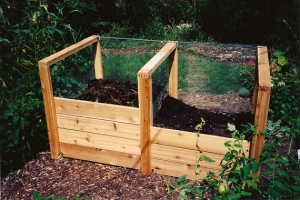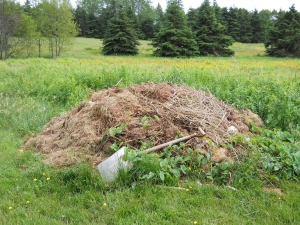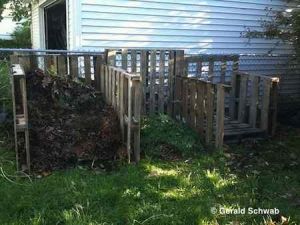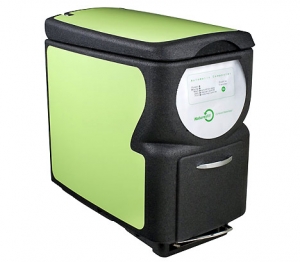Seven Cool Ways to Get Your Compost On!
 Imagine a pile of trash 2000 feet tall, one mile wide, and 85 million tons heavy. An enormous pile, almost large enough to be seen from space.
Imagine a pile of trash 2000 feet tall, one mile wide, and 85 million tons heavy. An enormous pile, almost large enough to be seen from space.
That’s how much compostable waste Americans discard in a single year.
According to the EPA, food scraps and yard waste account for 20 to 30 percent of what we throw away. These scraps sit unused in landfills, where they contribute approximately 34% of all man-made methane gas to the atmosphere. More methane in the atmosphere means more global warming.
Which is why home-composting is so important.
But with so many methods out there, which is the right one? And what if you don’t have a yard? What if you’re on a budget? How do you know where to start?
The following is a list of 7 of the most common and practical ways to compost:
1. Basic Pile.
 Doesn’t get any easier/cheaper than this. Just pick a spot in your yard and—you guessed it—start a pile. Grass clippings, leaves, kitchen scraps, coffee grounds etc are all fair game. (Just no meat; it stinks!). If you’re really motivated, you can throw a tarp over your pile when it rains: too much water slows down the aeration process. Even if you do nothing else, your scraps will eventually turn into beauteous compost
Doesn’t get any easier/cheaper than this. Just pick a spot in your yard and—you guessed it—start a pile. Grass clippings, leaves, kitchen scraps, coffee grounds etc are all fair game. (Just no meat; it stinks!). If you’re really motivated, you can throw a tarp over your pile when it rains: too much water slows down the aeration process. Even if you do nothing else, your scraps will eventually turn into beauteous compost
2. Enclosure:
 Kick it up a notch by building yourself a little enclosure. Chicken wire will get the job done, but you can also use wood from old pallets. An enclosure will help prevent your scraps from blowing into your neighbor’s yard, and will also ensure a higher internal temperature, thus a faster return on your investment. Turn every so often with a pitchfork, and the gift of compost will soon be yours.
Kick it up a notch by building yourself a little enclosure. Chicken wire will get the job done, but you can also use wood from old pallets. An enclosure will help prevent your scraps from blowing into your neighbor’s yard, and will also ensure a higher internal temperature, thus a faster return on your investment. Turn every so often with a pitchfork, and the gift of compost will soon be yours.
3. Basic bin:
 If space is an issue, why not use an old trash can, bucket, or barrel? More discreet than the enclosure or pile, and ideal for the compost-minded townie. If you’re looking for something with a little more class and/or functionality, ready-made compost bins come with lids and small doors for ease of removing finished soil. For quicker results, balance your ingredients—2 parts brown to 1 part green.
If space is an issue, why not use an old trash can, bucket, or barrel? More discreet than the enclosure or pile, and ideal for the compost-minded townie. If you’re looking for something with a little more class and/or functionality, ready-made compost bins come with lids and small doors for ease of removing finished soil. For quicker results, balance your ingredients—2 parts brown to 1 part green.
4. Spinning Composter:
 The name says it all. Same as the aforementioned bin, but pitched horizontally, and set on an axle. Simply add your scraps and give it a whirl! The process of spinning, or ‘tumbling’, adds oxygen and expedites the decomposition. Store-bought models are a little spendier, but there are a number of cheap DIY solutions available online.
The name says it all. Same as the aforementioned bin, but pitched horizontally, and set on an axle. Simply add your scraps and give it a whirl! The process of spinning, or ‘tumbling’, adds oxygen and expedites the decomposition. Store-bought models are a little spendier, but there are a number of cheap DIY solutions available online.
5. Vermicomposting:
 Composting with worms! Premade kits complete with worms are available online, or you can make your own. Drill drainage holes in rubber made bin, add dampened shredded newspaper, cardboard, and worms, and then slowly introduce food scraps, keeping them buried to deter fruit flies. The worm ‘casings’ –poop for us laypeople—can then be used as potting soil! If you’re worried about smell, don’t be: I promise, Vermicomposting does NOT smell. Perfect for folks in an apartment.
Composting with worms! Premade kits complete with worms are available online, or you can make your own. Drill drainage holes in rubber made bin, add dampened shredded newspaper, cardboard, and worms, and then slowly introduce food scraps, keeping them buried to deter fruit flies. The worm ‘casings’ –poop for us laypeople—can then be used as potting soil! If you’re worried about smell, don’t be: I promise, Vermicomposting does NOT smell. Perfect for folks in an apartment.
6. Automatic Hot Composter:
 Probably the priciest of indoor composting options, this is nevertheless one of the coolest, quickest ways to get the job done. Capable of mixing and aerating up to five pounds of food a day—automatically! And, you can even add dairy, meat and fish! Every two weeks you’ll have yourself a fresh batch of gorgeous compost.
Probably the priciest of indoor composting options, this is nevertheless one of the coolest, quickest ways to get the job done. Capable of mixing and aerating up to five pounds of food a day—automatically! And, you can even add dairy, meat and fish! Every two weeks you’ll have yourself a fresh batch of gorgeous compost.
7. Microbe Composter:
 Similar to vermicomposting, but uses special microbes called Bokashi to digest organic scraps. The Bokashi composting container, a not unattractive bucket, can be kept in a closet or alongside your wastebasket. And best of all: it only takes a couple weeks before you have dense, lush, compost!
Similar to vermicomposting, but uses special microbes called Bokashi to digest organic scraps. The Bokashi composting container, a not unattractive bucket, can be kept in a closet or alongside your wastebasket. And best of all: it only takes a couple weeks before you have dense, lush, compost!
So you see, no matter what your living situation or budget, there’s a composting solution that’s right for you!
